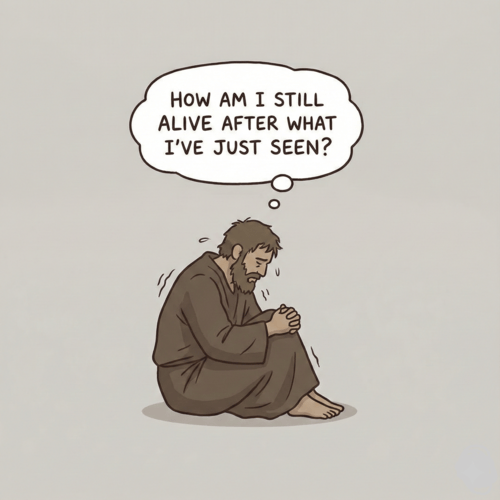What The Demon-Possessed Man Teaches Us About True Conversion
CALVINISM’S ‘TULIP’ ON DISPLAY IN MARK 5
The waves crashed violently against the small boat as Jesus and His disciples fought through a terrifying storm on the Sea of Galilee. Any reasonable person would have turned back. But Jesus pressed on through the tempest with singular determination—because on the other side of that lake was a man who desperately needed saving.
What happened next in Mark 5 isn’t just one of the Bible’s most dramatic deliverance stories. It’s a perfect picture of how salvation actually works, displaying each element of Calvinism’s TULIP doctrine—of Total depravity, Unconditional election, Limited atonement, Irresistible grace, and Perseverance of the saints—in vivid, unforgettable detail. This demon-possessed man’s transformation from tormented outcast to transformed missionary reveals salvation as God’s work from start to finish.
STAGE 1: THE HELPLESS SINNER: OUR TOTAL DEPRAVITY
When Jesus stepped onto the shore, He was immediately confronted by a man in the most desperate condition imaginable. Mark describes a person completely enslaved by “Legion”—thousands of demons who’d made his body their fortress.
The picture is horrifying: a man living among the tombs like he was dead, crying out day and night in anguish, cutting himself with stones, breaking every chain and shackle that tried to bind him. He possessed supernatural strength yet was utterly powerless to free himself. No human solution could help him. No therapy, no medicine, no willpower could break his bondage.
This man represents every one of us before conversion: We may not live in graveyards or break physical chains, but spiritually we’re just as enslaved. Paul tells us we were “dead in trespasses and sins” (Ephesians 2:1), controlled by “the prince of the power of the air” (Ephesians 2:2). Like this man, we might appear strong on the outside while being completely helpless on the inside.
The doctrine of Total Depravity doesn’t mean we’re as bad as we could be—it means we’re so corrupted by sin that we cannot save ourselves. Just as this man couldn’t cast out his own demons, we cannot free ourselves from sin’s power. We need a Saviour to do what we cannot do.
STAGE 2. THE SEEKING SAVIOUR: UNCONDITIONAL ELECTION
Here’s what makes this story remarkable: Jesus came looking for this man, not the other way around.
The demon-possessed man never sent an invitation. He never prayed for deliverance. He never even knew he needed Jesus. Yet Jesus deliberately sailed through a life-threatening storm to reach him. Why would the Son of God risk His life and His disciples’ lives for one tormented soul in Gentile territory?
Because of Unconditional Election. God’s choice to save sinners isn’t based on anything good He sees in us—it’s based entirely on His sovereign grace and love. Jesus didn’t come because this man deserved rescue. He came because He had chosen to rescue him.
This is the heart of the gospel that so many miss. We don’t choose God first—He chooses us. “You did not choose me, but I chose you,” Jesus told His disciples (John 15:16). Before the foundation of the world, God set His love on specific individuals and determined to save them. This man was one of them, and if you’re a believer, so are you.
The storm Jesus weathered to reach this man represents the cross He endured to reach us. Both required Him to brave the wrath and fury that stood between Him and those He came to save.
STAGE 3. THE AMAZING DELIVERANCE: LIMITED ATONEMENT AND IRRESISTIBLE GRACE
What happened next was immediate and complete transformation. With a word from Jesus, the Legion was expelled and the man was:
- Clothed instead of naked—his dignity restored
- Sitting instead of running wild—at peace and in control
- At Jesus’ feet instead of among the tombs—in fellowship with the living
- In his right mind instead of tormented—mentally and spiritually whole
This demonstrates both Limited Atonement and Irresistible Grace. Jesus came specifically for this man and accomplished exactly what He intended. His power didn’t just make salvation possible—it made salvation actual. The man couldn’t resist the transforming work of Christ any more than the demons could resist His command to leave.
Limited Atonement doesn’t mean Jesus’ sacrifice was insufficient for all—it means it was effective for the elect. When God sets His saving love on someone, that love accomplishes its purpose. His grace doesn’t merely offer salvation; it secures it.
Notice the man contributed absolutely nothing to his deliverance. He didn’t help cast out the demons, didn’t choose to be clothed, didn’t decide to sit at Jesus’ feet. God did it all. This is monergistic salvation—salvation that is entirely God’s work.
STAGE 4: THE ENEMY IS ANGRY, BUT THE ‘SAVED’ PERSEVERE
The story takes an unexpected turn when the townspeople arrive. Instead of rejoicing over this miraculous transformation, they were terrified and begged Jesus to leave their region immediately.
Why such hostility to obvious good? Because the enemy was furious. Satan had lost a stronghold, and he immediately began working through others to oppose what God had done. The people cared more about their lost pigs than this man’s found soul.
This opposition actually proves the conversion was real. As Peter warns, “Your adversary the devil walks about like a roaring lion, seeking whom he may devour” (1 Peter 5:8). When someone is genuinely saved, Satan doesn’t give up—he doubles his efforts.
But here’s the beautiful truth of Perseverance of the Saints: What God starts, He finishes. Jesus didn’t abandon this man to face the opposition alone. Though He physically departed, He left the man as His representative, telling him to “go home to your friends, and tell them what great things the Lord has done for you” (Mark 5:19).
The man who had been tormented by demons became a fearless missionary. Mark tells us he “began to proclaim in the Decapolis all that Jesus had done for him; and all marvelled” (Mark 5:20). The same power that delivered him from demons now sustained him through persecution.
This is the promise for every believer: The God who saved you will keep you. The grace that found you when you were helpless will preserve you when enemies oppose. You may face storms, but you will not be shipwrecked.
SALVATION: GOD’S WORK FROM START TO FINISH
The story of the demon-possessed man strips away every trace of human boasting about salvation. From beginning to end, it was entirely God’s work:
- God sought him when he was lost in spiritual death
- God chose him without any merit on his part
- God delivered him completely and immediately
- God sustained him through opposition and rejection
This is how salvation actually works for every believer. We contribute nothing but our sin and need. God contributes everything—the seeking, the choosing, the saving, and the keeping. The demon-possessed man’s deliverance was obvious, immediate, and lasting. He couldn’t help but tell others what Jesus had done.
But what if we face opposition like this man did? Let’s take comfort. The devil’s attacks often intensify after conversion because he’s lost a soul he once controlled. But the same Jesus who cast out the Legion is the same Jesus who keeps His people. What He has begun in us, He will complete.
The demon-possessed man’s story isn’t just ancient history—it’s the pattern of every true conversion. It reveals salvation as the work of a sovereign God who seeks the lost, chooses the unworthy, saves the helpless, and keeps the weak. That’s a Saviour worth risking everything to know, and a salvation worth telling the world about.
THE DEMON-POSSESSED MAN: RELATED FAQS
Why did Jesus allow the demons to enter the pigs instead of just destroying them? Jesus wasn’t merely accommodating the demons’ request that they be allowed to enter the pigs. RC Sproul suggests the destruction of the pigs demonstrated the true cost of sin and evil—death and destruction are sin’s natural wages. Additionally, it provided undeniable proof to the townspeople the deliverance was real; the dramatic destruction of 2,000 pigs couldn’t be dismissed as psychological healing. The economic loss also revealed the townspeople’s twisted priorities—they valued their livestock more than a human soul’s salvation.
- How do Arminians interpret this passage? Arminians typically emphasise the man “ran and worshiped” Jesus (v.6), arguing this shows he exercised faith and chose to come to Christ, demonstrating free will in salvation. They contend Jesus responded to the man’s approach rather than sovereignly initiating the encounter. Reformed theologians like John MacArthur counter the man’s running and worship were themselves the result of God’s irresistible grace already working in him—dead sinners don’t seek God unless first made alive. The very fact a demon-possessed man could worship proves God had already begun His saving work, not that the man contributed his own faith.
- What do Reformed scholars say about Jesus traveling specifically to Gentile territory? John Calvin saw this journey as a powerful demonstration of God’s sovereign election extending beyond ethnic Israel to include Gentiles in His saving purposes. Sinclair Ferguson notes Jesus’ dangerous crossing to reach one man in “unclean” territory perfectly illustrates how God’s electing love crosses every barrier—geographic, ethnic, social, and spiritual. RC Sproul emphasised that Jesus didn’t stumble upon this man by accident; the storm-tossed journey was as intentional as the cross itself, showing how far God will go to save His elect.
Could this man have resisted Jesus’ deliverance if he wanted to? The question strikes at the heart of irresistible grace. The demons themselves provide the answer—they begged Jesus not to torment them and asked permission to enter the pigs, showing they had no power to resist His will. If supernatural evil spirits couldn’t resist Christ’s command, how much less could a sin-enslaved human resist God’s saving grace? Reformed theologian Louis Berkhof argued irresistible grace doesn’t override the will but transforms it, making the sinner willing and able to respond to God. The man’s worship wasn’t coerced but was the natural response of a heart that had been sovereignly regenerated.
- Why didn’t Jesus let the man follow Him like other disciples? Jesus’ command for the man to “go home to your friends and tell them what great things the Lord has done” reveals God’s sovereign plan for each believer’s calling. DA Carson notes this wasn’t rejection but commission—Jesus was establishing His first Gentile missionary in the Decapolis region. The man’s powerful testimony (Mark 5:20 says “all marvelled”) prepared the way for Jesus’ later ministry in that area. This demonstrates how God’s sovereign purposes work through our circumstances; the man’s previous local reputation made him the perfect evangelist for his community.
- What does this passage teach about the relationship between mental illness and demonic possession? While some modern interpreters attempt to explain this account purely in psychological terms, Reformed scholars maintain the distinction between illness and possession that Scripture clearly makes. John MacArthur notes Jesus consistently treated demon possession and physical/mental ailments as separate categories throughout the Gospels. However, this doesn’t mean all mental illness is demonic—rather, it shows spiritual realities can manifest in physical and psychological symptoms. The man’s immediate, complete transformation upon deliverance demonstrates this was supernatural bondage requiring supernatural intervention, not merely therapeutic treatment.
How does this account relate to modern deliverance ministries? Reformed theology approaches this carefully, affirming demonic reality while avoiding sensationalism. Scholar Wayne Grudem notes that while demon possession occurs, the New Testament shows it was particularly prominent during Christ’s earthly ministry as Satan marshalled his forces against the incarnate Son of God. Modern Reformed pastors like John Piper emphasise our primary weapons against spiritual darkness are Scripture, prayer, and proclamation of the Gospel rather than dramatic exorcism rituals. The demon-possessed man’s deliverance came through Jesus’ sovereign word, not through extended spiritual warfare techniques—pointing us to trust in Christ’s finished work rather than our own spiritual efforts.
THE DEMON-POSSESSED MAN: OUR RELATED POSTS
Editor's Pick

The Throne-Room Vision: Who Did Isaiah See?
The scene is unforgettable: Isaiah stands in the temple, and suddenly the veil between heaven and earth tears open. He [...]

The Angel of the Lord: Can We Be Certain It Was Christ All Along?
Throughout the Old Testament, a mysterious figure appears: the Angel of the LORD. He speaks as God, bears God’s name, [...]
SUPPORT US:
Feel the Holy Spirit's gentle nudge to partner with us?
Donate Online:
Account Name: TRUTHS TO DIE FOR FOUNDATION
Account Number: 10243565459
Bank IFSC: IDFB0043391
Bank Name: IDFC FIRST BANK






